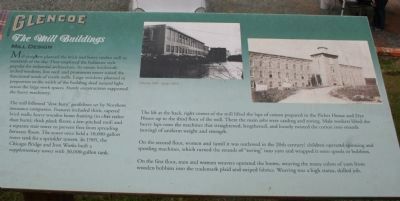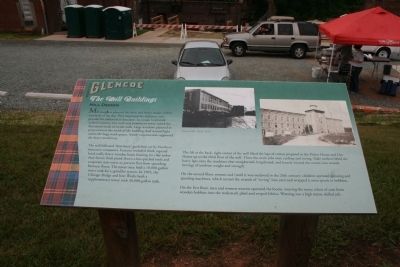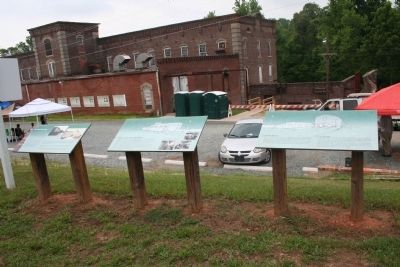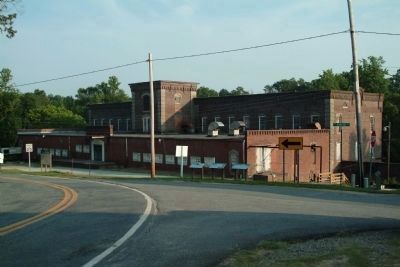Glencoe Village near Burlington in Alamance County, North Carolina — The American South (South Atlantic)
The Mill Buildings
Mill Design
— Glencoe —
The mill followed "slow burn" guidelines set by Northern insurance companies. Features included thick, tapered brick walls; heavy wooden beam framing (to char rather than burn); thick plank floors; a low-pitched roof; and a separate stair tower to prevent fires from spreading between floors. The tower once held a 10,000-gallon water tank for a sprinkler system. In 1905, the Chicago Bridge and Iron Works built a supplementary tower with a 30,000-gallon tank.
The lift at the back, right corner of the mill lifted the laps of cotton prepared in the Picker House and Dye House up to the third floor of the mill. There the main jobs were carding and roving. Male workers lifted the heavy laps onto the machines that straightened, lengthened, and loosely twisted the cotton into strands (roving) of uniform weight and strength.
On the second floor, women and (until it was outlawed in the 20th century) children operated spinning and spooling machines, which turned the strands of "roving" into yarn and wrapped it onto spools or bobbins.
On the first floor, men and women weavers operated the looms, weaving the many colors of yarn from wooden bobbins into the trademark plaid and striped fabrics. Weaving was a high status, skilled job.
Topics. This historical marker is listed in these topic lists: Industry & Commerce • Settlements & Settlers. A significant historical year for this entry is 1905.
Location. 36° 8.337′ N, 79° 25.679′ W. Marker is near Burlington, North Carolina, in Alamance County. It is in Glencoe Village. Marker is on Glencoe Street, on the left when traveling west. Glencoe Village is 3 miles north of Burlington, NC from NC Highway 62. Touch for map. Marker is at or near this postal address: 2406 Glencoe St, Burlington NC 27217, United States of America. Touch for directions.
Other nearby markers. At least 8 other markers are within walking distance of this marker. After the Whistle Blows (here, next to this marker); Picker House and Dye House (here, next to this marker); Men in the Mill Village (here, next to this marker); African Americans in the Mill Village (here, next to this marker); Women in the Mill Village (here, next to this marker); Neighbors Divided (a few steps from this marker); Calling the Mill Village 'Home' (a few steps from this marker); Children in the Mill Village (a few steps from this marker). Touch for a list and map of all markers in Burlington.
Additional keywords. Textiles, Glencoe Cotton Mills, Alamance, Burlington, Holt, fabric
Credits. This page was last revised on May 11, 2023. It was originally submitted on June 5, 2010, by Patrick G. Jordan of Graham, North Carolina. This page has been viewed 1,096 times since then and 15 times this year. Last updated on May 9, 2023, by Michael Buckner of Durham, North Carolina. Photos: 1, 2, 3. submitted on June 5, 2010, by Patrick G. Jordan of Graham, North Carolina. 4. submitted on June 29, 2010, by Patrick G. Jordan of Graham, North Carolina. • J. Makali Bruton was the editor who published this page.



